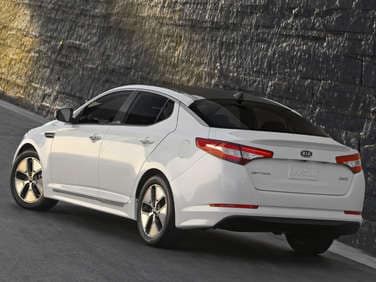Recent Articles
Popular Makes
Body Types
2011 Kia Optima Hybrid Road Test & Review
Kia Optimizes the Optima
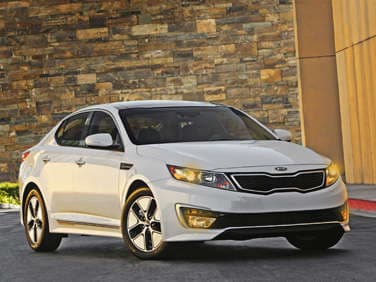
The anti-guzzler: can it handle the long haul?
Here’s the bad news: In many parts of the country, gas is $4 a gallon. Here’s the good news: The 2011 Kia Optima hybrid delivers up to 40 mpg on the highway. And here’s even more good news: the Optima hybrid works in full electric mode at speeds up to 62 miles per hour, depending on your driving style. Which makes this new electric-gas hybrid a great contender for short hauls and city driving. It will also aid in fuel savings for adventures beyond the now-popular staycation.
Why a Kia hybrid now?
The race for automakers to deliver hybrid models has never been hotter. The days of the original, Jetsons-esque Honda Insight are far behind us, with an all-new Honda Civic hybrid and carmakers from Chevy (Volt) to Lexus (RX 450h, CT 200h, etc.) and, now, value-priced player Kia, throwing lithium-ion powered models into the ring.
The 2011 Optima is a mid-sized sedan with a growing list of admirers as well as accolades for its capability and features content, with media outlets from MSNBC.com to Kiplinger’s Personal Finance to Ward’s naming it to top-picks lists; the Insurance Institute for Highway Safety and the U.S. Government both have recognized the sedan for its high performance in safety tests.
Now, Optima has to prove itself all over again, with the addition of a hybrid model to its lineup.
We drove this newcomer from the bustling freeways of Los Angeles to the cheeky desert city of Palm Springs. “It had us at hello”! We loved its swooopy looks from the start, and slipped behind the wheel into a cockpit that is not only attractively-styled, but come with a host of appealing features, especially when you consider its price. As we polled others in Palm Springs, many found it alluring, although some say the exterior is over-designed and too busy.
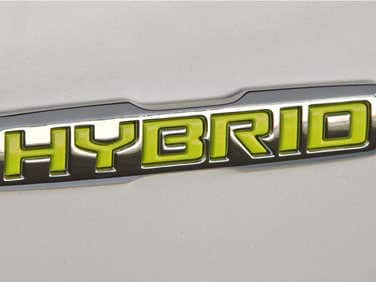
A new approach to the powertrain
The 2011 Kia Optima lineup includes two non-hybrid models: a 2.4-liter inline four-cylinder making 200 hp. and 186 lb.-ft. of torque, and a turbocharged model that adds 74 horses and 83 lb.-ft. Rounding out the lineup is the all-new hybrid model, which puts the inline four-cylinder in parallel with an electric system powered by lithium polymer batteries. The battery-powered system delivers 40.2 horsepower and 151.2 pound-feet of torque when in electric only, and 206 hp./195 lb.-ft. of torque in hybrid mode.
Kia believes the system is unique. Compared to power-split hybrid systems in Toyota and Ford models, for example, Kia chose a Transmission-Mounted-Electric-Drive (TMED) layout, with the electric motor separated from the transmission gear-set.
This means two things: first, the motor is easily paired with the existing Optima six-speed automatic transmission. So, Kia didn’t have to reinvent the powertrain to invent this set of wheels. Second, this modular approach makes it easier for Kia engineers to change out components of the traditional and hybrid motors to add more powerful configurations or new types of batteries as technologies continue to advance. This is the future of fuel savings.
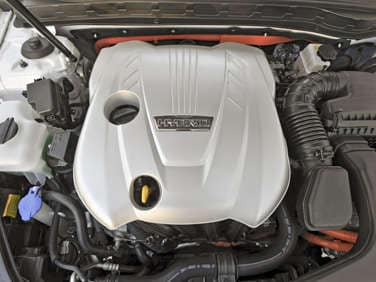
Lightened up
Hybrid vehicles are often associated with being heavy and slow to respond – and, typically, batteries tend to weigh a lot. But the Optima hybrid is one of the lightest cars in the segment at 3,490 pounds (just shy of 250 pounds lighter than Ford’s Fusion hybrid) and we experienced great power on tap at all times throughout the rev range, even up the steep foothills of the Sierras that bank this desert enclave. Power from both systems comes on in a unified fashion, without the clunk or slight halt of some hybrids.
The newest Optima is “slippery”, which means it has been revised to improve aerodynamics and rolling resistance. It also has a lower ride height, an active air flap system, lower drag wheels and underbody aero tuning to reduce drag, while low rolling-resistance tires increase efficiency. Its drag coefficient is 0.26. All aid in fuel savings.
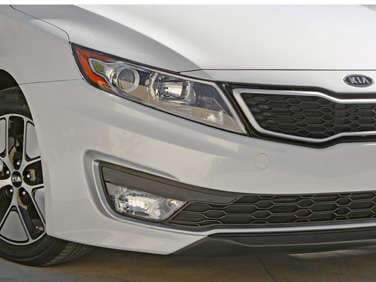
The hybrid power grid
The 2011 Optima hybrid system recovers energy lost during braking and stores it for use during acceleration and cruising, so when the brake pedal is applied, the engine is decoupled from the traction motor and, thereby, gives no drag on the vehicle. The motor is then used as a generator to recharge the hybrid battery. This also means that the Optima’s brakes last longer: there’s less friction when the energy is converted into kinetic, not thermal, power.
An Electric Power Assist Steering (EPAS) system instantly provides boost, but only when it is needed during steering maneuvers. EPAS is independent of the engine and also provides assistance when the engine is not running, such as during idle stop or electric drive mode.
The Optima Hybrid’s air conditioning compressor is electrically driven; in the daytime heat of Palm Springs, which is known as “fairway to heaven”, we found it heavenly that cool air can keep blasting even when the engine is off. This next-generation air compressor also helps cut fuel consumption in all drive modes – gas, electric and hybrid.
Four-wheel antilock brakes (ABS), Electronic Stability Control (ESC), a Traction Control System (TCS), a Brake Assist System (BAS) and Hill Assist Control (HAC) also are standard.

All this and a pretty face
Like all Optimas, the hybrid model has a fresh look for 2011, including a sly grin of a front end and black honeycomb accents both within the grille and air vents below. Both the front grille and rear bumper design are unique to the LEV (hybrid) model.
Air vents just below the A-pillar, scooped-out sides and jagged, cut-glass-like taillights give the Optima a higher-than-its-price-point appearance. The look is more Euro sport sedan than economy family car. Wheels are 16-inch alloys; chrome accents brighten up door handles.
Inside, the cabin is comfy but not too plush, with a bunch of comfort and convenience features that help this value-priced sedan fight above its weight in the mid-size segment. Power-adjustable driver lumbar support is standard, for example, as is an eight-way power adjustable driver's seat, dual zone automatic temperature control with rear vents and push-button start with smart key. The mid-sizer seats five and has cargo space enough for a family weekend away or a haul of supplies from Target.
Standard upholstery is cloth, with leather available as an option. A leather-wrapped steering wheel and shift knob, automatic up/down on front windows, chrome interior door handles, glove box illumination, rear reading lamps, and fixed rear seats, with ski pass-through, are also among the standard features. Another very clever touch is a pre-recorded engine sound that plays on the outside during electric-only operation to notify passers-by, especially in crosswalks and on bicycles, that the nearly-silent hybrid is approaching.
The 2011 Optima Hybrid also offers a Premium Technology Package with a panoramic sunroof, 17-inch alloy wheels, four-way power adjustable front passenger's seat, driver's seat memory, heated and cooled front seats, heated rear seats and steering wheel, HID headlamps with automatic leveling, leatherette-wrapped center fascia, auto-dimming rear-view mirror with Homelink™ and compass, a navigation system with back-up camera and SIRIUS Traffic™1, and an eight-speaker Infinity 2 audio system.

The Takeaway
Even though its electric-exclusive drive mode can only handle speeds up to 62 mph, Kia’s first foray into hybrid technology in the U.S. market shows some serious promise. This car hits the middle ground between luxury and economy without compromising too much in terms of fit-and-finish, and the styling would be pretty at twice the price. Even in shared electric/gas mode, your fuel gauge will read at 30-plus mpg on the highway. Along with a 10-year, 100,000-mile warranty, we think this makes the 2011 Optima hybrid a good bet for the long haul.
